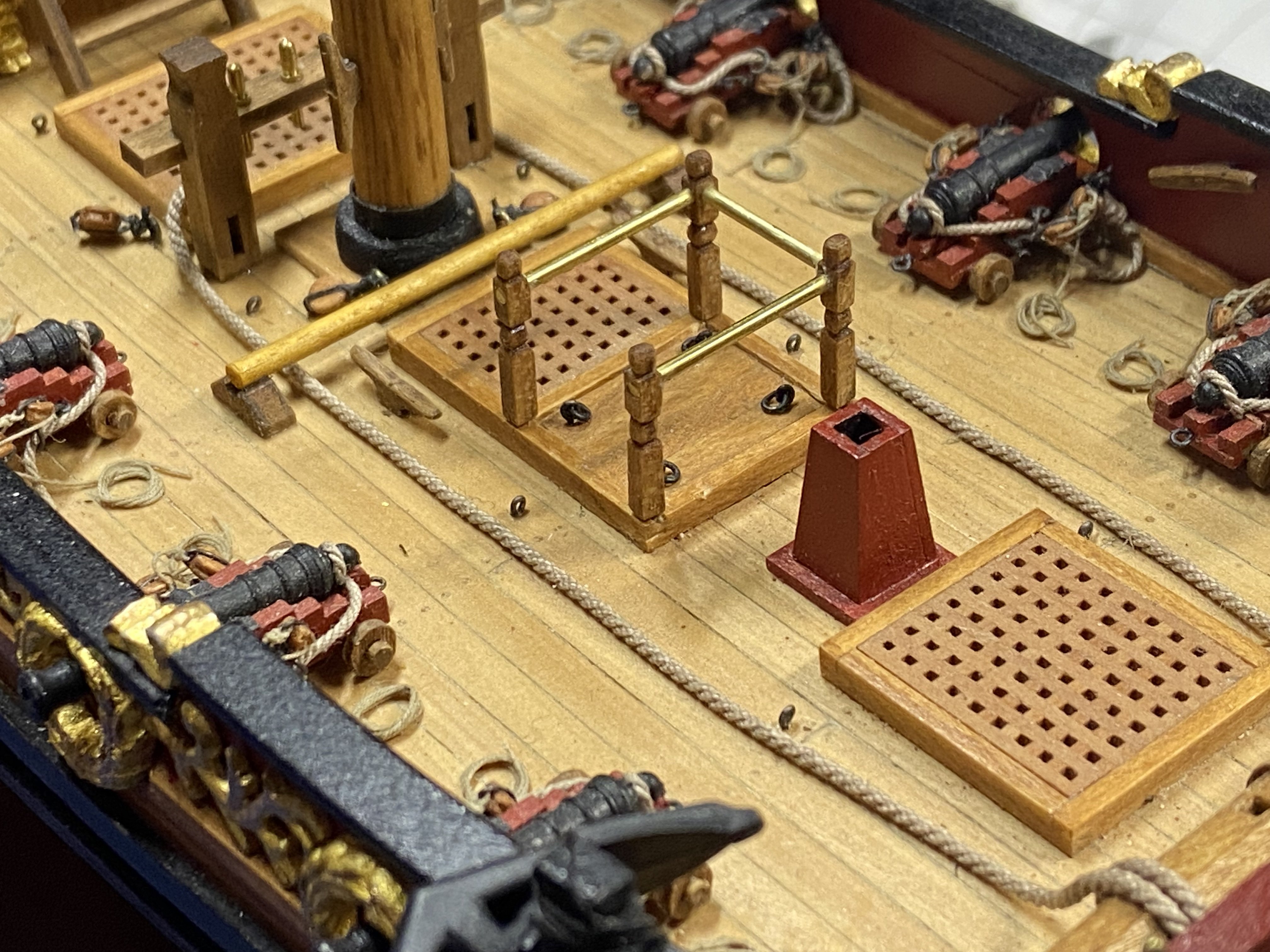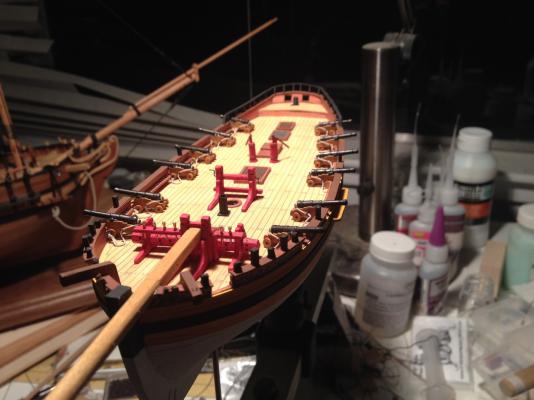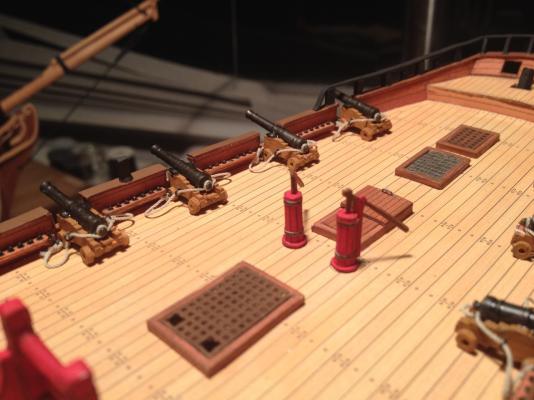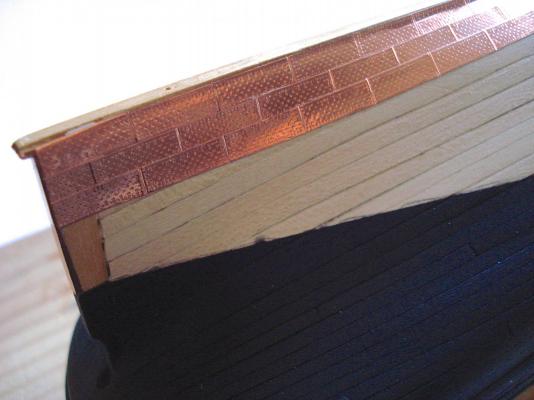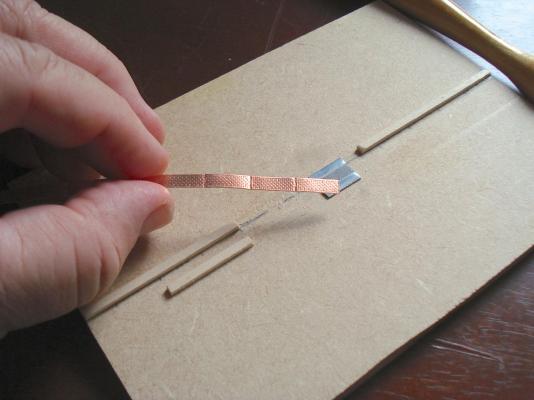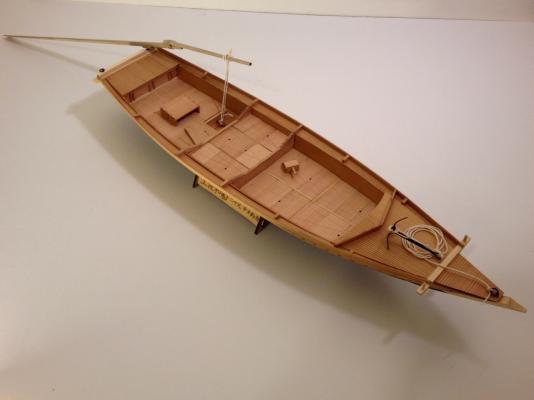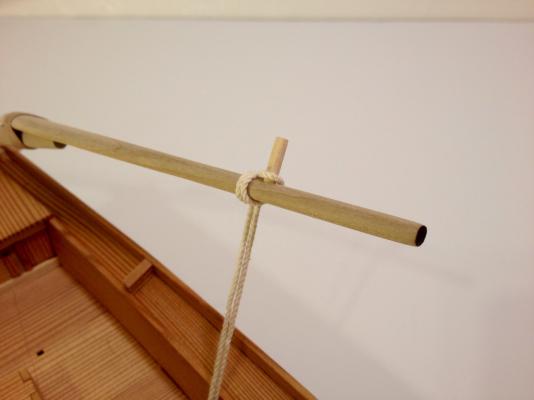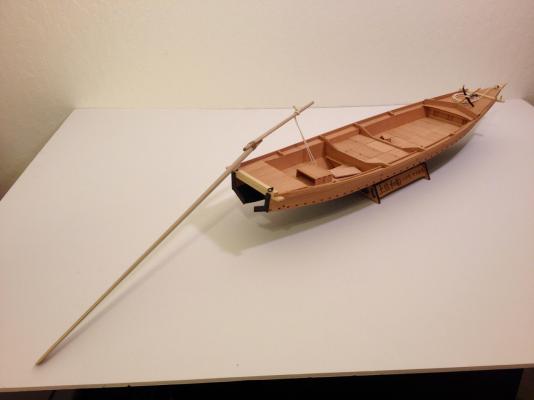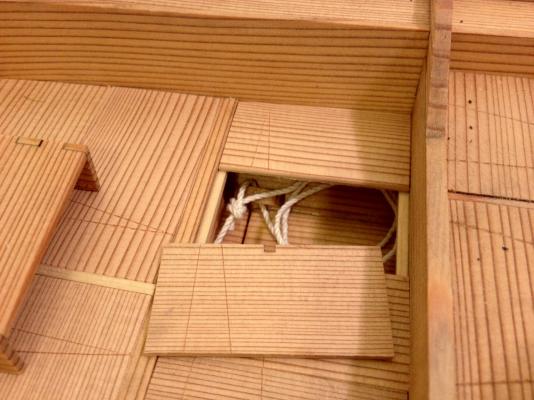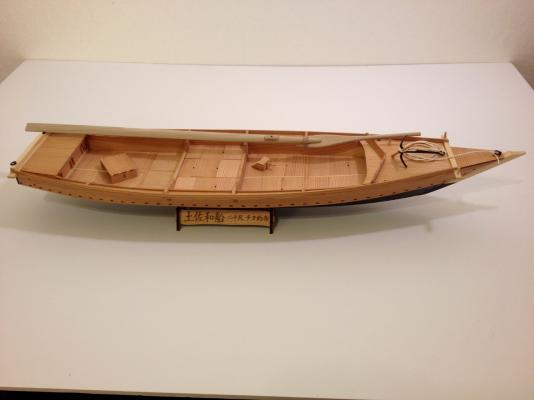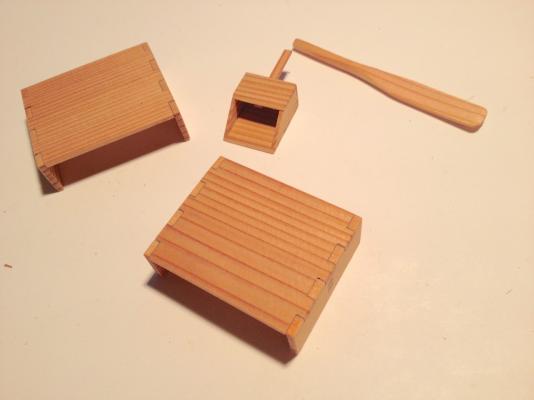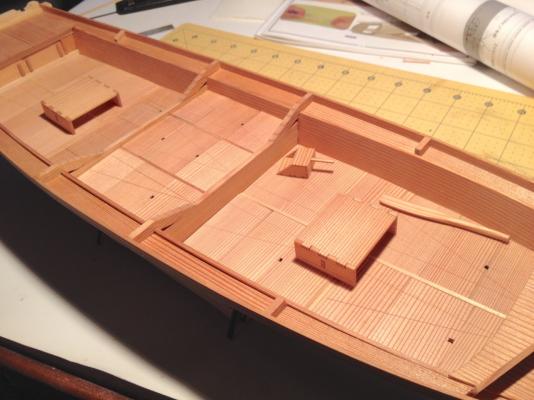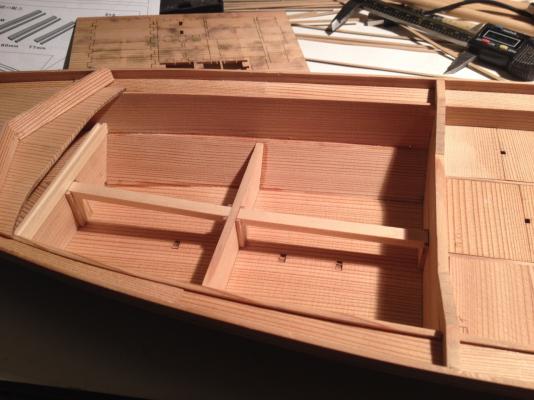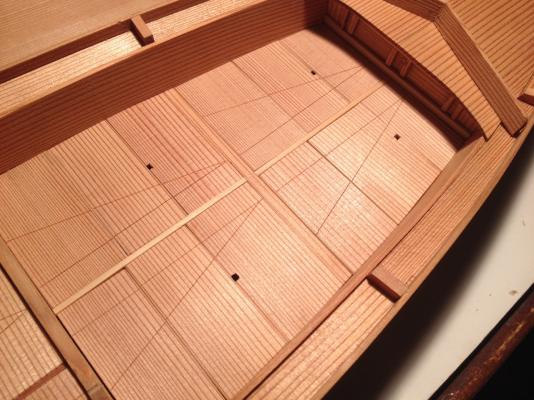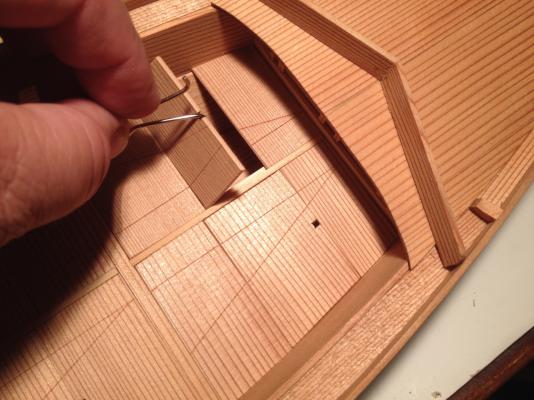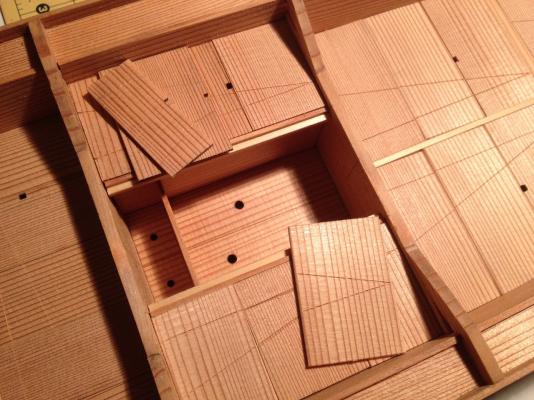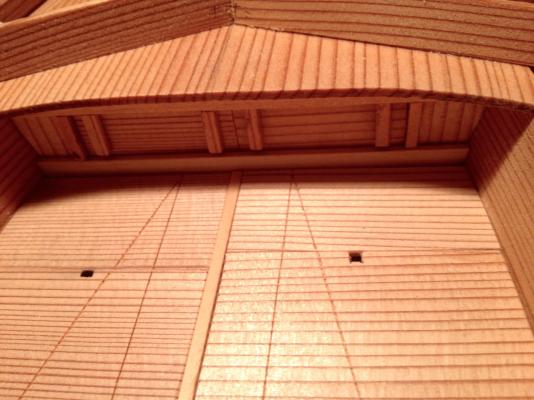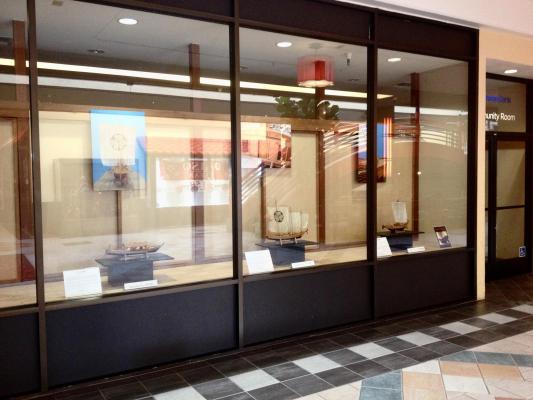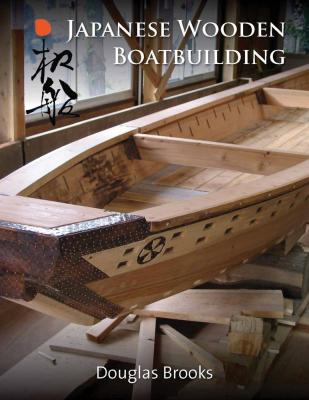-
Posts
1,856 -
Joined
-
Last visited
Content Type
Profiles
Forums
Gallery
Events
Everything posted by catopower
-
Thanks for the supportive comments Cog, Druxey, Telp and Mark. Cog, okay, you're probably right... Watch. My next paper (card) model will probably have open bulwarks! Telp, I doubt I'll ever go down the path of 3D printing, though there are some 3D printed parts that I'm sure I'll use. I already bought a 3D printed ship's wheel for a 1:78-scale HMS Victory model. I won't necessarily use it if I can make one that looks good enough. Overall, I like building the parts myself, even if they're not perfect. Of course, with a paper kit, it's a different game, with its own challenges. Don't know that I'd ever feel up to the task of scratch-building a paper model. For now, I'll stick to kits, or at least to this one kit. But, I have to admit, I picked up another Shipyard kit (HMS Mercury) that I thought I might partially build as a display model showing the hull construction style. I also thought one would make a great dockyard scene with the ship's hull completed and ready for launch – a follow up to a discussion here on flags mounted on a Royal Navy ship at launch. Clare
-
Thank you Nils. Of course, I can't take credit for making the cannons out of card. I decided my skills weren't up to doing that and having something nice looking, so I did purchase swivel guns from Chuck Passaro's Syren Ship Model Company and adapted them for 1/92-scale 6-pounder guns. I had the hardest time with all the timberheads and the taffrail. Next time I build a paper model, I think it will have no railing like on this one! Clare
-
Thanks for the kind words Ron! Well, small update here... I've been trying to wrap up one project and put some time into a big project – can't get very far on large 3-masted ships if you don't put in the hours! But, a friend of mine is interested in the Alert model, and I'm really not that far from the end since the rig is so simple. So, I thought I'd make a little progress by installing the carriage guns. I've had the guns done for some time now, but fitting them into place along with their breech ropes means drilling small holes in paper, gluing eyebolts into place in very small places, etc. I epoxied pins on the underside of the guns to help position and secure them to the deck. Holes were drilled at each of the gunport openings as well as at either side of the gunports. I'd already secured eyebolts to the ends of the breech ropes, so now they just had to be trimmed and glued into place. I used gap-filling CA for this. I found that I didn't have enough room to glue the eyebolts to the bulwarks with the cannon in place, so I let the cannons flop around while I installed the breech rope eyebolts. When these were dry, I mixed up some epoxy and glued the cannons down to the deck. The pins, even epoxied, didn't hold the guns securely in all cases. So, on some guns, I put a little glue underneath, close to the rear axles. Definitely tricky trying not to spoil the appearance of the printed paper deck. I manage to get a small shiny spot on the deck from glue. I ended up having to give a shot of Testor's Flat Lacquer Clear Coat, which worked extremely well hiding the shiny spot. Clare
-
jbford, what is it that you are building that you don't think is good enough for nice quality rigging line? You will definitely find that the good stuff will enhance your build and your enjoyment. Of course, if you're rigging a 3-masted ship, it might take a good supply of line. I turned my own rigging line early on, but I was never really very satisfied with what I could produce. I have given in to the wisdom of buying line from Chuck Passaro – it's really nice stuff! Clare
-
Tadeuz, There is something particularly disturbing about running across ones own photos that someone else posted without so much as an acknowledgement. Worse yet, it's mixed in with copper plates from kits! These copper plates are made from tape that I embossed using a die a created. Shown below (and the earlier post above), is the hull of my scratch built U.S.S. Saginaw hull) I gave up on all manufactured copper plates 20 years ago as none of them are realistic - all are way out of scale. The closest I've seen to looking correct are the ones that BlueJacket makes, but they are REALLY expensive. Unfortunately, I like the look of a coppered hull, so I've had to work on improving mine ever since my first wooden ship model, the pilot boat Phantom, with its coppered hull. However, I haven't gotten a European nail pattern down yet. That's coming up soon. But, I've always liked using copper tape. It's available in a wide variety of sizes – not just the couple sizes regularly sold by ship modeling sites. It's also very thin and can be overlapped the way actual copper plates were applied and not unrealistically butted together. They're also much cheaper than pre-fab plates of any manufacturer, and are copper all the way through. Clare
-
Hi Dave, Congrats on starting your build and build log here! In reality, my model's scale is somewhere in between 1:40 and 1:48. It's so close in design to being a kit of the Halifax, that I've been using elements of that ship to build this model. There's actually a lot of "fudge factor" in my model! Also, I actually used plain pear wood, not swiss pear. I got some from The Lumberyard that was very dark in color. I bought more in sheet and rough cut form and think I must have gotten the last of the dark pear wood supply. I've seen other models that used pear wood (again, not swiss pear) and it was much lighter. In any case, I'm really looking forward to watching your progress. Clare
-
Hi Andy, Looks like you don't have many options there. I agree with your original thoughts. Don't look at the bulkheads, just lay your center plans between the center of stem and center of transom. You're deck will be wider to one side, but only slightly. It won't be noticeable unless you're looking really closely. Only problem I can see is that you're masts will be slightly off center too. Shrouds on one side will be slightly longer than on the other. But, looks like you're only talking about 1/8", so you should be fine. The photo of your model from the side looks great, by the way. Clare
-
Thank you Phil and David, for the nice comments. Sorry I haven't posted in a while. I had reason to work on some other things. One of those is a big project that is close to completion and then I have someone who wants the Alert and would like it in the next few months. So, I'll press ahead. Hopefully, the end of the build will go as well as the start of it. But, I have no experience rigging a paper model. The masts and yards are all wood, so that's no problem. However, I sense the need to be particularly careful about the shrouds, deadeyes and chainplates. I'm actually wondering if I can work out a way to set the upper deadeyes, then rig the ratlines off the model. In theory, if I could set up a stand that holds the mast and a set of lower deadeyes in the exact position, everything should work out. No? Now, one thing that happened recently is that I can't get any more of the pear wood blocks I bought from Syren Ship Model Company. I probably have enough for this rig. But, I've been thinking about switching to paper blocks anyway. It IS a paper model, after all. I've only rigged a few blocks, so those should be easy enough to replace. Hope it all looks good! Clare
-

molding casting metal
catopower replied to michael101's topic in Metal Work, Soldering and Metal Fittings
Hi Michael, For metal casting, I like the 10 to 1 RTV silicone rubber that Micromark sells. It can take up to 600˚ F or about 450˚ sustained.I tried using stuff from TAP Plastics, which works, but it's thicker and harder to work with I think. I started casting Britannia Pewter, but the melt temperatures are high and so I started using a Tin/Bismuth alloy. I recommend staying away from lead. Rotometals.com has a whole range of low melt alloys and their prices are much better than buying them from Micromark. Personally, I enjoyed learning the new skill. Clare -
Funny, but I ran into the same question today... I'm working on a 1770s colonial schooner with windlass. I just got the line for the anchor cables in the mail today and went to mount them. Then, I realized I wasn't sure which way to run them. I was trying to look at photos of Harold Hahn's work, but, dare I say, I think he might have it wrong. It's actually kind of hard to say as the photos I have don't show the windlass very clearly. Most photos are about the general structure of his models, not on the rigging details. But, I think he has the anchor cable coming off the bottom of the windlass and backwards from the way Harland describes in his book. So, SOS, I think you're right. In Harland's book on page 263, bottom of first column, he writes "The cable was taken three times around the barrel, the turns coming off the top, the inboard part being kept to the outer end, to facilitate fleeting the turns." Clare
-
Hi Phil, There are probably plenty of people on MSW who can chime in with better answers than mine. You're right in the Bluenose II being a wooden hull ship. In fact, I don't think I've ever built a wooden model of a steel hull ship. Well, at least until Sir Winston Churchill. So, I've never had to worry about trying to get rid of wood grain or planking outlines. For my Woody Joe Sir Winston Churchill model, I've been using plain old Elmer's wood filler on the hull. Regular sanding sealer can be applied after filling. In fact, it seems to harden the filler a bit, which is otherwise pretty soft. I'm not sure what to do about an undercoat prior to painting yet. I haven't gotten there, but will have to figure that out pretty soon. I saw on another thread where someone recommended using a coat of Future on the hull to get a smooth finish. I've never tried that though, so I can't say that it works well or not. Clare
-
Hi Phil, Nice progress on your SWC. I always liked the Billing Boat series of kits that has you build the hull in halves. I built their Bluenose II kit that way and it all went together quite nicely. I recently received the update Woody Joe kit (Japanese manufacturer) of the Sir Winston Churchill which is the exact same scale as the Billing Boats kit. Your blog and the posts by various people here are very helpful. There are some details that seem a little simplified in the Woody Joe kit, so I've been scouring the Internet and calling on various resources. I didn't see anyone mention this here yet, but there are some neat short videos about the ship on Youtube. This one seems to be a spliced together compilation of them: If you can put up with the use of the Wagner music in a couple spots, most of it is actually well narrated. I've had a hard time finding good reference photos, so this video turned out to be a godsend for me. Clare
-
Hello "The Old Man", Birch plywood is fine for bulkheads and strong back. Just get stuff that's flat as others have said. Aircraft grade is nicer to work with, but in the end, what you're using should be just as good. I'd suggest using something nicer for the actual visible keel, stem and sternpost though. I like to use boxwood for those, even with kits. I've cut off the existing stem and keel of those "all in one" keel/strong back pieces and replace them with boxwood (or pear wood) pieces, built up as with the real ships and nobody can tell the inside is just plywood. Using nice wood for those visible areas will avoid bad looking edges and the wood discoloration you're getting, and would allow you to leave the visible wood natural if you like. Clare
-
A fine finish to your beautiful build, Bob! You should send your photos to Woody Joe. They would love to see it too. Clare
- 196 replies
-
- higaki kaisen
- woody joe
-
(and 1 more)
Tagged with:
-
Bob, Excellent job on the Mariefred! Your model is a great advertisement for Nordic Class Boats – a superb build! Clare
- 50 replies
-
- mariefred
- nordic class boats
-
(and 1 more)
Tagged with:
-
grsjax, I've been scouring the Internet for more than a year for Japanese wooden boat/ship model kits. If you check my Tosa Wasen build, that kit is the only non-Woody Joe wooden boat kit that I'm aware of from Japan. Clare
-

1/10-scale Japanese Fishing Boat kit from Thermal Studios
catopower replied to catopower's topic in Wood ship model kits
Wefalck, Actually, some of what was recorded by Pâris seems very good . What kind of craft are you looking for? Douglas Brooks has a few drawings of small boats in his book. You might also try contacting him about more comprehensive plans of the watercraft he studied. You can contact him through his website at http://www.douglasbrooksboatbuilding.com. Beyond that, I doubt you'll find much. Japanese boatbuilding traditions didn't include the use of plans the way we're accustomed to in western traditions. Also, I don't think there's a great deal of interest in preserving this kind of information in modern Japanese society, except among a small handful of people. Clare -
Here it is, the final entry on the Tosa Wasen build. I took a little time figuring out the knots used for the anchor, which had a Japanese name. Also, I wanted the model to represent an Edo period boat, though I couldn't find any information of the exact age of this design. In fact, this small fishing boats of the Tosa region were built to the needs of the individual and there were many boat builders, so there were probably many variations. But, the model is done and I'll figure out how I want to display it next. As you can see, with the Ro in place (the long sculling oar), the model is quite long. With it in the stowed position, it's 2' long. With no masts, it will fit easily on a bookcase shelf, unlike most of my other models. This has been a really interesting build and great kit for those who don't want to go as far as using Douglas Brooks' drawings and the information in his book to try to scratch building a traditional Japanese boat. I think this is about as close as you're ever going to get in a kit. Still, I'd recommend reading his book while building this kit, to really get the fullest experience. I plan on bringing this to the NRG Conference in San Diego this Fall. So, hopefully, ship modelers who don't get around to trying out this kit can see it in person. But, if you're interested in building this kit, don't wait. Here again is the contact info for buying the kit from the manufacturer who seems very happy to sell to faraway customers, payment via Paypal. Email Mr. Tanimura at: Thermal-Studio Website: Thermal-Studio (remember the boat kit is not listed – They manufacture glider kits) If you contact Tanimura-san, please say hello for me. Also, be sure to check out Mr. Toshihiko Shibafuji, who assisted with the design of the kit: http://wave.ap.teacup.com/wasennfunadaiku/ Hope to see some more of these in build logs here on MSW soon. (Yeah, I'm thinking about you, Bob) Clare
- 51 replies
-
- wasen
- thermal studio
-
(and 1 more)
Tagged with:
-
While I'm at, I thought I'd go ahead and post some pictures of some of the accessories included in the kit. These include a bailer, a small paddle, and a pair of wooden seats. These were a fun and easy part of the build and add some life to the model. In earlier pics, to get them out of the way, I just put them into the compartments under the deck. Getting close to the finish now. Should be done in the next one or two posts... Clare
- 51 replies
-
- wasen
- thermal studio
-
(and 1 more)
Tagged with:
-
The next step in construction of the Tosa Wasen kit is to add the deck boards. This part of the build turned out to be a lot tricker than I'd expected. This is an area where you really want to take your time, and it's easy to want to rush through it. The deck boards serve as a deck to walk (or sit) on and work on, but they are also designed to be removable, allowing the fisherman access to storage space under the deck. This allows the deck to be kept clear and free of clutter, making for a tidy looking boat. Beam supports glued into place. The beams are sanded to fit, but I left them unglued, so they'll remain removable. Ledges are then cut to length and glued to the beams for the deck boards to rest upon. The deck boards themselves are rather interesting in that they are made such that almost no two are alike. Each one can only fit in one location, with the possible exception of the boards that cover the live wells in the center of the boat. But, given that there are many boards, it would seem to be something of a puzzle trying to figure out which one fits where. To make the positioning more obvious, there are two lines scribed into the top of the boards. The lines form a sort of an arrowhead with the point at the front of the forward most board, and each compartment has a 3 or more deck boards covering it, with its own arrowhead pattern scribed on it. This makes for a quick recognition of the order of the deck boards and also makes it easier to keep from mixing them up. Note that at least one deck board of each set has a square notch cut into one edge that serves as a finger hole to make it easier to pull up the board. The kit supplies the deck boards as laser-cut pieces, which look they'd make it easy to put them into place. However, in order to allow some variation between models, these parts are cut over-sized, so they have to be sanded to fit. This turned out to be a far trickier than I'd expected, as the Japanese cedar is pretty soft, and really wanted to avoid small gaps between boards. In fact, I used every scrap piece of cedar that I could find in the kit in order to finish the deck boards. If you're building this kit, Proceed Very Carefully here The next step was to scribe the patterns into the deck boards. I found it easiest to take each group of deck boards which are part of the same pattern set and marking the endpoints on the first and last board, then scribing them all together as a group. I lined them up against a straight edge to keep them in alignment. This was pretty much the last of the difficult work. There is one more step that was a little tricky, but in a completely different way, and that was the next step. For those following along with the kit instructions, this is step 33. This involves the construction of the covers for the cargo compartments in the bow and the stern of the boat. If you haven't built the model kit yet, I would suggest doing this work in steps 17 and 18 before the compartments are decked over. It would just be a lot easier. I'm not positive why the kit has you build the compartment covers now instead of earlier in the build. Possibly, it's because the real boat would probably be built in the order shown in the kit. That would be okay, except that trying to reach in with your finger and thumb to get the covers into place without knocking parts into the compartments is pretty difficult. The kit includes a small pair of wooden tweezers that you're instructed to build for handling those compartment doors. In the long run, these will be necessary in order to be able to remove or replace these doors without damaging the wood. Clare
- 51 replies
-
- wasen
- thermal studio
-
(and 1 more)
Tagged with:
-
Happy New Year All! Well, I have made a little more progress on the Tosa Wasen, but I'll post that later. For now, I'm taking a moment to mention that if you're in San Francisco, my wasen model display in Japantown has been extended through January. It's in the Japan Center's East Mall building, in the window of Union Bank's community room. The next one I imagine will be in late Spring perhaps. It all depends on what others have scheduled for the display window. But, rest assured the next one will include the Tosa Wasen. Also, with the start of the new year, I thought I'd take a moment to plug Douglas Brooks' book, Traditional Japanese Boatbuilding. This won't tell you step-by-step how to build a Japanese boat, but it will give you all the background about traditional Japanese boatbuilding, materials and tools used, and you can see some of the techniques used and read about Mr. Brooks' five apprenticeships with some of the rapidly disappearing master boat builders of Japan. I recommend ordering the book direct from the author's website as all profits go to helping support research instead of supporting the resellers (not that there's anything wrong with resellers). Here the link: douglasbrooksboatbuilding.com Clare
- 51 replies
-
- wasen
- thermal studio
-
(and 1 more)
Tagged with:
-
Hi Bob, That's great news. Of course, judging from your Higaki Kaisen model, you're final model will probably look better than mine. Anyway, I'm hoping they get a lot of international sales for this kit now. Clare
- 51 replies
-
- wasen
- thermal studio
-
(and 1 more)
Tagged with:
-

1/10-scale Japanese Fishing Boat kit from Thermal Studios
catopower replied to catopower's topic in Wood ship model kits
I posted this in my build log, but it makes sense to put the info here too. Buying the Tosa Wasen Kit If you're looking to buy the kit, there is a faster, less expensive method than trying to get it through Amazon-Japan where I got mine. I found out that you can buy it from the manufacturer for a very good price. To buy from the manufacturer, send an email to the company: info@thermal-kobo.jp. Price for the kit is 13,000 Yen Shipping is via EMS (A Chinese Express Mail Service that ends with a USPS delivery) for 2,400 Yen Payment has to be via Paypal, sending to the email address above. This is a really good price. Makes the whole thing with express shipping only about $130. I went ahead and ordered a second kit. The only thing that I'm not so sure about is that the kit is shipped in its own box, but wrapped with a bubblewrap bag. It's a long box, so it seems like it would be easy to bend in half. But, I received the first kit this way and it was delivered just fine. Then again, I generally have good experiences with the US Postal Service here. It looks like I might have been their first international sale as the owner posted a picture of the kit shipping out to the USA on their Facebook page. I hope he sells a lot of kits! Clare
About us
Modelshipworld - Advancing Ship Modeling through Research
SSL Secured
Your security is important for us so this Website is SSL-Secured
NRG Mailing Address
Nautical Research Guild
237 South Lincoln Street
Westmont IL, 60559-1917
Model Ship World ® and the MSW logo are Registered Trademarks, and belong to the Nautical Research Guild (United States Patent and Trademark Office: No. 6,929,264 & No. 6,929,274, registered Dec. 20, 2022)
Helpful Links
About the NRG
If you enjoy building ship models that are historically accurate as well as beautiful, then The Nautical Research Guild (NRG) is just right for you.
The Guild is a non-profit educational organization whose mission is to “Advance Ship Modeling Through Research”. We provide support to our members in their efforts to raise the quality of their model ships.
The Nautical Research Guild has published our world-renowned quarterly magazine, The Nautical Research Journal, since 1955. The pages of the Journal are full of articles by accomplished ship modelers who show you how they create those exquisite details on their models, and by maritime historians who show you the correct details to build. The Journal is available in both print and digital editions. Go to the NRG web site (www.thenrg.org) to download a complimentary digital copy of the Journal. The NRG also publishes plan sets, books and compilations of back issues of the Journal and the former Ships in Scale and Model Ship Builder magazines.

